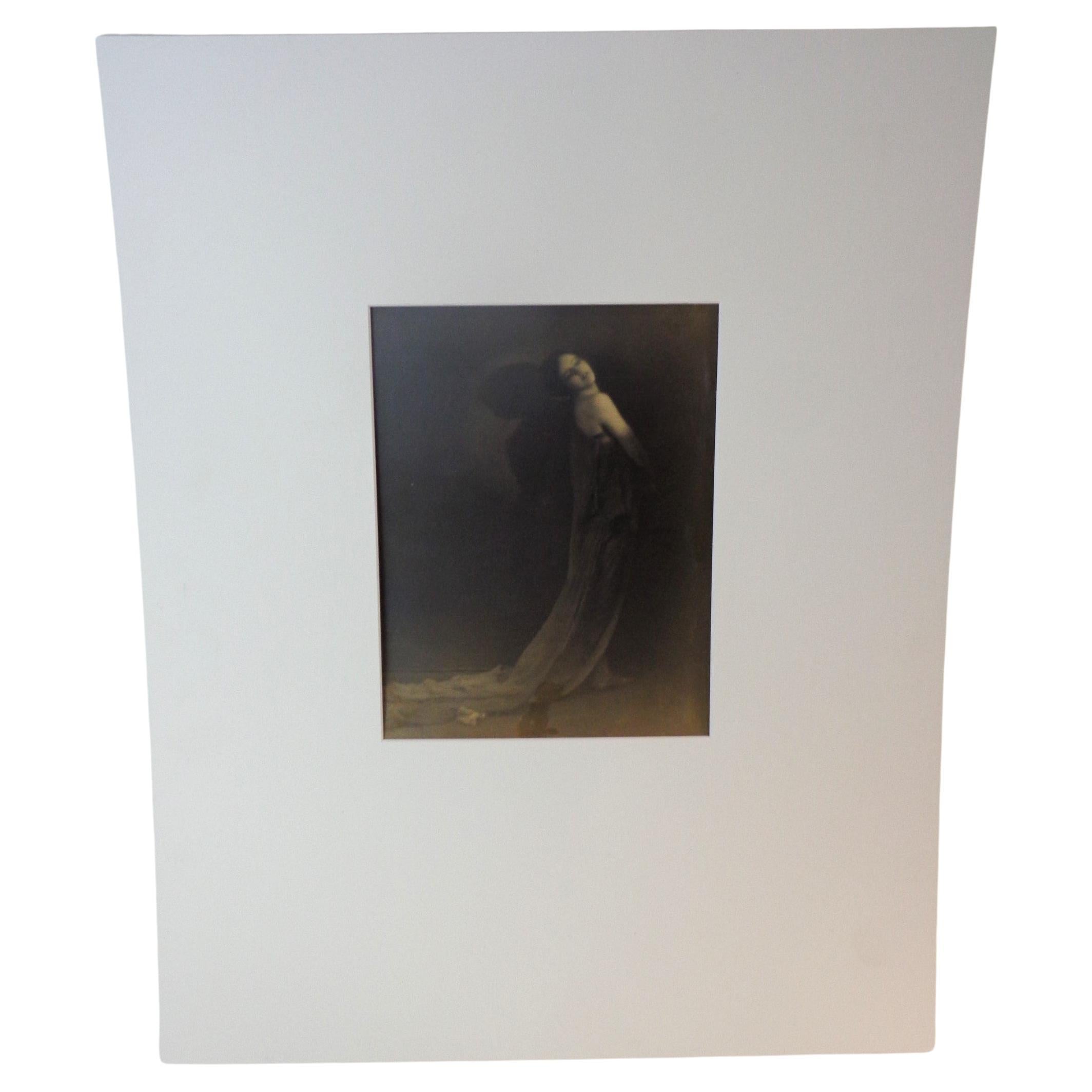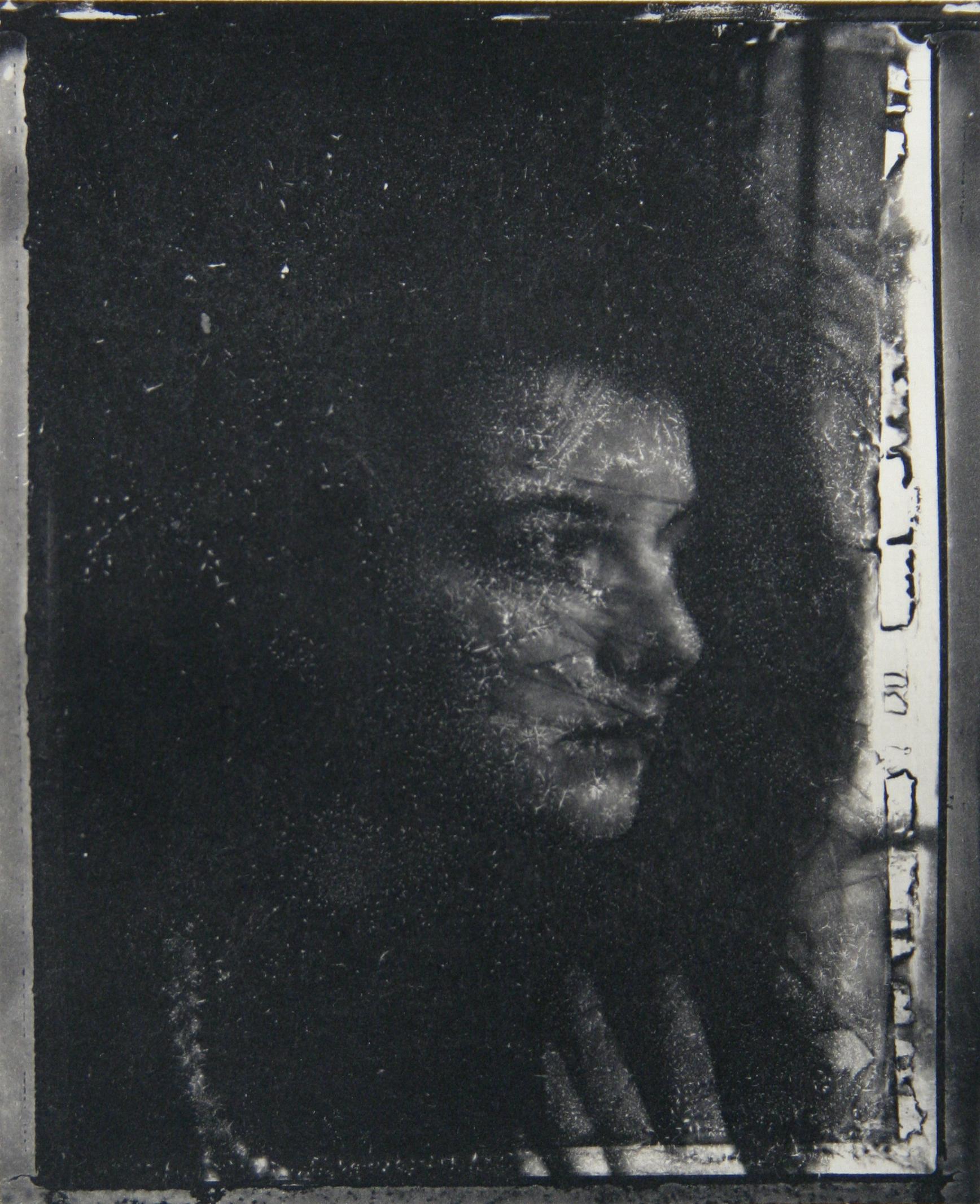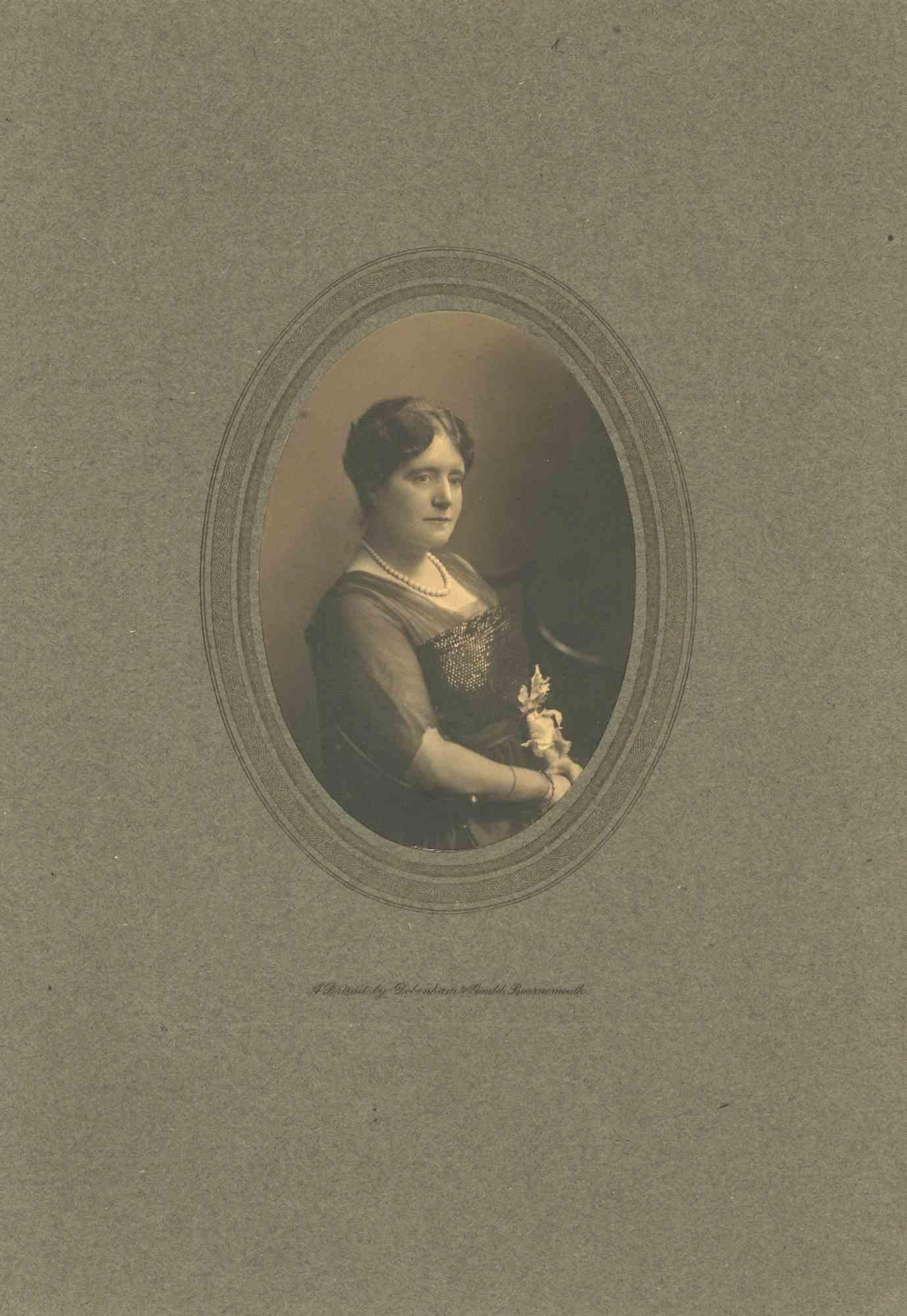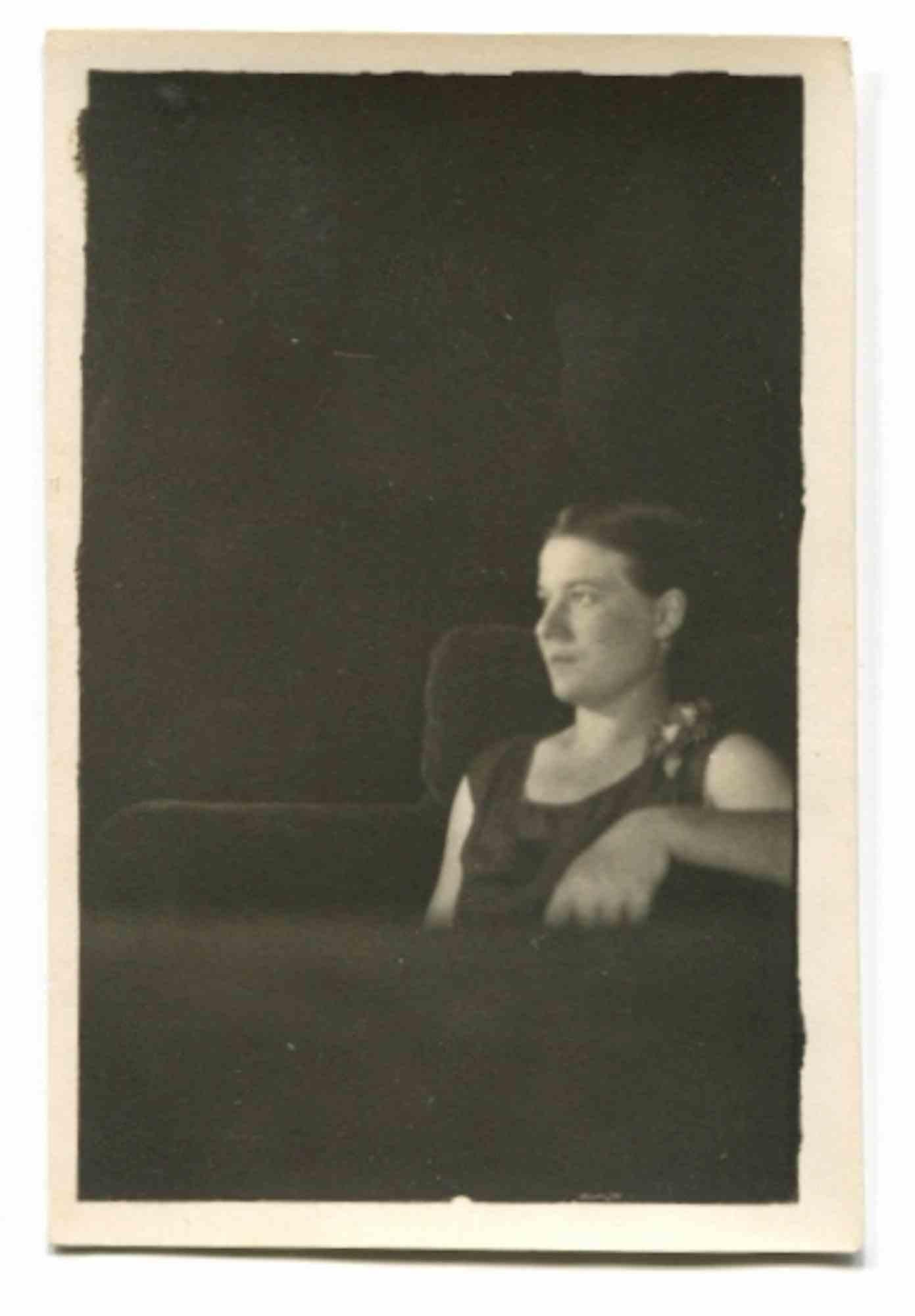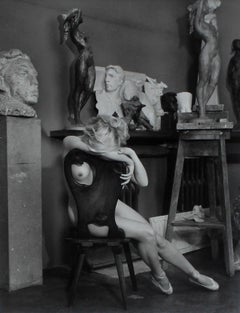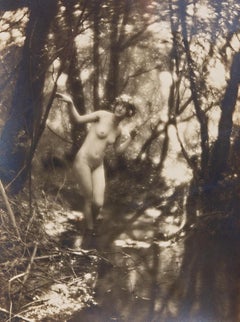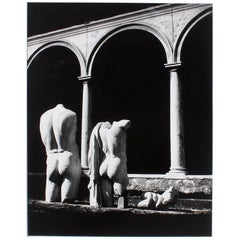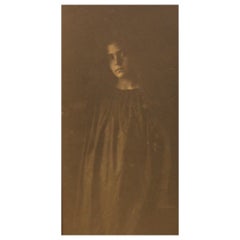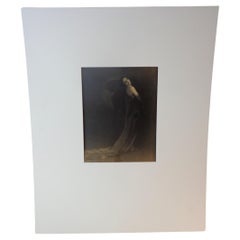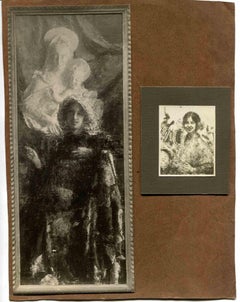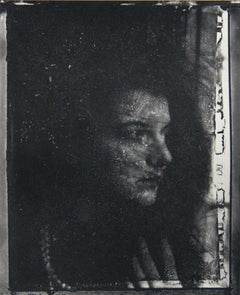Items Similar to Pictorialist Photography, "Pensive Woman"
Want more images or videos?
Request additional images or videos from the seller
1 of 4
UnknownPictorialist Photography, "Pensive Woman"Circa 1910
Circa 1910
$495
£377.93
€436.70
CA$694.89
A$774.52
CHF 406.37
MX$9,458.19
NOK 5,145.47
SEK 4,863.26
DKK 3,259.25
About the Item
Pictorialist photograph of a young woman. Silver print in the original oak frame. Inscribed on reverse R.S. Paddock, Early 20th century.
Pictorialism is the name given to an international style and aesthetic movement that dominated photography during the later 19th and early 20th centuries. There is no standard definition of the term, but in general it refers to a style in which the photographer has somehow manipulated what would otherwise be a straightforward photograph as a means of "creating" an image rather than simply recording it. Typically, a pictorial photograph appears to lack a sharp focus (some more so than others), is printed in one or more colors other than black-and-white (ranging from warm brown to deep blue) and may have visible brush strokes or other manipulation of the surface. For the pictorialist, a photograph, like a painting, drawing or engraving, was a way of projecting an emotional intent into the viewer's realm of imagination.[1]
Pictorialism as a movement thrived from circa 1885-1915, although it was still being promoted by some as late as the 1940s. It began in response to claims that a photograph was nothing more than a simple record of reality, and transformed into an international movement to advance the status of all photography as a true art form. For more than three decades painters, photographers and art critics debated opposing artistic philosophies, ultimately culminating in the acquisition of photographs by several major art museums.
Pictorialism gradually declined in popularity after 1920, although it did not fade out of popularity until the end of World War II. During this period the new style of photographic modernism came into vogue, and the public's interest shifted to more sharply focused images. Several important 20th century photographers began their careers in a pictorialist style but transitioned into sharply focused photography by the 1930s.
This style is defined first by a distinctly personal expression that emphasizes photography's ability to create visual beauty rather than simply record facts.[4] However, recently historians have recognized that pictorialism is more than just a visual style. It evolved in direct context with the changing social and cultural attitudes of the time, and, as such, it should not be characterized simply as a visual trend. One writer has noted that pictorialism was "simultaneously a movement, a philosophy, an aesthetic and a style."[5]
Contrary to what some histories of photography portray, pictorialism did not come about as the result of a linear evolution of artistic sensibilities; rather, it was formed through "an intricate, divergent, often passionately conflicting barrage of strategies."[6] While photographers and others debated whether photography could be art, the advent of photography directly affected the roles and livelihoods of many traditional artists. Prior to the development of photography, a painted miniature portrait was the most common means of recording a person's likeness. Thousands of painters were engaged in this art form. But photography quickly negated the need for and interest in miniature portraits. One example of this effect was seen at the annual exhibition of the Royal Academy in London; in 1830 more than 300 miniature paintings were exhibited, but by 1870 only 33 were on display.[7] Photography had taken over for one type of art form, but the question of whether photography itself could be artistic had not been resolved.
Some painters soon adopted photography as a tool to help them record a model's pose, a landscape scene or other elements to include in their art. It's known that many of the great 19th century painters, including Delacroix, Courbet, Manet, Degas, Ce´zanne, and Gauguin, took photographs themselves, used photographs by others and incorporated images from photographs into their work.[8] While heated debates about the relationship between photography and art continued in print and in lecture halls, the distinction between a photographic image and a painting became more and more difficult to discern. As photography continued to develop, the interactions between painting and photography became increasingly reciprocal.[9] More than a few pictorial photographers, including Alvin Langdon Coburn, Edward Steichen, Gertrude Ka¨sebier, Oscar Gustave Rejlander, and Sarah Choate Sears, were originally trained as painters or took up painting in addition to their photographic skills.
It was during this same period that cultures and societies around the world were being affected by a rapid increase in intercontinental travel and commerce. Books and magazines published on one continent could be exported and sold on another with increasing ease, and the development of reliable mail services facilitated individual exchanges of ideas, techniques and, most importantly for photography, actual prints. These developments led to pictorialism being "a more international movement in photography than almost any other photographic genre."[10] Camera clubs in the U.S., England, France, Germany, Austria, Japan and other countries regularly lent works to each other's exhibitions, exchanged technical information and published essays and critical commentaries in one another's journals. Led by The Linked Ring in England, the photo-secession in the U.S., and the Photo-Club de Paris in France, first hundreds and then thousands of photographers passionately pursued common interests in this multi-dimensional movement. Within the span of little more than a decade, notable pictorial photographers were found in Western and Eastern Europe, North America, Asia and Australia.
Secessionist.
- Creation Year:Circa 1910
- Dimensions:Height: 10 in (25.4 cm)Width: 6 in (15.24 cm)Depth: 1 in (2.54 cm)
- Medium:
- Movement & Style:
- Period:
- Condition:
- Gallery Location:Rochester, NY
- Reference Number:Seller: portrait impressionist mid modern secessionist art1stDibs: LU165028959012
About the Seller
5.0
Vetted Professional Seller
Every seller passes strict standards for authenticity and reliability
1stDibs seller since 2021
37 sales on 1stDibs
Typical response time: 16 hours
- ShippingRetrieving quote...Shipping from: Rochester, NY
- Return Policy
Authenticity Guarantee
In the unlikely event there’s an issue with an item’s authenticity, contact us within 1 year for a full refund. DetailsMoney-Back Guarantee
If your item is not as described, is damaged in transit, or does not arrive, contact us within 7 days for a full refund. Details24-Hour Cancellation
You have a 24-hour grace period in which to reconsider your purchase, with no questions asked.Vetted Professional Sellers
Our world-class sellers must adhere to strict standards for service and quality, maintaining the integrity of our listings.Price-Match Guarantee
If you find that a seller listed the same item for a lower price elsewhere, we’ll match it.Trusted Global Delivery
Our best-in-class carrier network provides specialized shipping options worldwide, including custom delivery.More From This Seller
View AllVintage Nude Black and White Photograph by Josef Ehm
By Josef Ehm
Located in Rochester, NY
Vintage black and white photograph, photography by Josef Ehm. "Resting Model II", circa 1960s, gelatin silver print. Framed size 10.5" x 13.5" . Image measures 8.5" x 6.5"
Josef Ehm:
Czech, 1909-1989.
Born in Habartov.
Apprenticed in professional photography studios until 1928.
Taught at the State...
Category
Mid-20th Century Modern Figurative Photography
Materials
Silver Gelatin
French Impressionist Painting Portrait of a Young Girl Paris School
Located in Rochester, NY
Striking French impressionist portrait of a young girl. Oil on board. Original carved frame. Circa 1950's. Signed illegibly lower right.
Category
Mid-20th Century Impressionist Figurative Paintings
Materials
Oil
Pictorialist Photograph Nude Wood Nymph by Charles Cook Circa 1910
Located in Rochester, NY
Pictorialist photograph of nude woman in a forest interior by Charles Cook. Silver print. Circa 1910.
Charles J. Cook was a painter and photo...
Category
1910s Nude Photography
Materials
Silver Gelatin
Black and White Photographs of Classical Male Nude Sculpture Set of Three
Located in Rochester, NY
Mid 20th century black and white photographs of classical sculpture. Set of three. As Mr Codax collected Czech photographers. Unsigned. Matted and framed.
Provenance: Estate of Phill...
Category
Mid-20th Century Nude Photography
Materials
Silver Gelatin
French Impressionist Painting Portrait of a Young Girl Paris School
Located in Rochester, NY
French impressionist boudoir portrait of a young woman. Oil on board. Original carved frame. Circa 1950's. Signed illegibly lower right.
Category
Mid-20th Century Figurative Paintings
Materials
Oil
Impressionist Painting of a Bohemian Woman Budapest 1925 Bertha De Hellebranth
Located in Rochester, NY
Bohemian woman Budapest, Hungary 1925 by Bertha De Hellebranth. Fabulous period painting brings to life the bohemian intelligentsia of Europe in the 1920's. I believe the painting is of the artists sister Elena Maria De Hellebranth. Both sisters were accomplished artist and worked and exhibited together. See the photo of the sisters Elena on the left and Bertha on the right. Oil on canvas. In a period frame. Signed lower right. Inscribed on reverse. Provenance: label from Newman Galleries Philadelphia.
BIOGRAPHY ; Bertha de Hellebranth and her sister Elena were born into a cultured upper-class family in Budapest, Bertha in 1899, Elena in 1897. Their father was a lawyer and their mother a student of Franz Liszt's last living pupil. Both sisters showed artistic potential early, beginning to paint at four or five years of age. Their parents encouraged them, and had the means to send them to the best art schools of the time. They studied at the Academy of Fine Art in Budapest, at the Académie Julian and the Académie de la Grande Chaumière in Paris, and painted portraits of European nobility. As Patricia Fazekas points out, "Growing up in a family of privilege, they seemed to have unusual access to many illustrious people." So we should not be surprised to find among their subjects members of high society, such as Count Andrássy Gyula, the Russian-born Princess Baby Galitzine, and Admiral Horthy Miklós, the Regent. Later on, their subjects included American heiress Gladys Vanderbilt (Countess László Széchenyi), President Theodore Roosevelt's granddaughter Paulina Longworth and former President Dwight D. Eisenhower.Often, the sisters would paint the same subject at the same time, offering the sitter a choice of portraits. Most often, the sitter wanted both renditions.While Elena concentrated on working in oil and watercolor, Bertha used gouache and oil to achieve her effects. Elena gave lectures and workshops, was a writer and also wrote popular and ecclesiastical music, while Bertha also went in for sculpture and handicrafts.From the mid-thirties until World War II, Bertha and Elena divided their time between their home in Budapest and a home on the ocean at Ventnor, NJ. In 1925, they showed their work at the Nemzeti Szalon in Budapest, and in 1926, they had a joint exhibition of their portraits in the US. Both exhibited their work at the Art Institute of Chicago, the Brooklyn Museum of Art, the Pennsylvania Academy of Fine Arts and most major museums and galleries in the US. Bertha also had exhibits at the Metropolitan Museum of Art. Both Bertha and Elena were Fellows of the Royal Society of Art (London), and garnered numerous prizes. Bertha was awarded First Prize by the National Academy of the American Water Color Society one year, and the Grand Prize of the Audubon Society. She was one of the founders of the now defunct World League of Hungarian Artists Abroad (Külföldi Magyar Képz?m?vészek Világszövetsége), and received a Gold Medal from the Cleveland Árpád Akadémia in 1963. (Elena also received the Akadémia's gold medal in 1965.) Their work is found in museums and galleries too numerous to mention.The de Hellebranth sisters were devout Catholics, and this is evident in their many portraits of clerics...
Category
Early 20th Century Impressionist Figurative Paintings
Materials
Fabric, Canvas, Oil
You May Also Like
Pictorialist Photography, "Pensive Woman"
Located in Rochester, NY
Pictorialist photograph of a young woman. Silver print in the original oak frame. Inscribed on reverse R.S. Paddock, Early 20th century.
Pictorialism is the name given to an intern...
Category
Early 20th Century American Modern Photography
Materials
Paper
Early Pictorialist Sepia Tone Gelatin Silver Print Photograph Woman
Located in Rochester, NY
Early original pictorialist sepia tone gelatin silver print photograph of a sultry young woman in a flowing gown by Rochester NY photographer Ned Hungerford, 1900-1910. Beautiful eth...
Category
Antique Early 1900s American Photography
Materials
Paper
Portraits - Photo- Early 20th Century
Located in Roma, IT
Portraits is a vintage black and white photograph realized in the early 20th Century.
Good conditions.
Category
20th Century Modern Figurative Photography
Materials
Photographic Paper
Untitled (Lynelle), black and white photograph by Mark Morrisroe
By Mark Morrisroe
Located in New York, NY
Untitled (Lynelle), black and white photograph by Mark Morrisroe
Untitled (Lynelle)
1986/1996
Editioned in pencil, verso
Photogravure (Edition of 46)
16 x 11 inches, sheet
4.25 x...
Category
1980s Contemporary Photography
Materials
Photogravure
Portrait of Lady - Photograph - Early 20th Century
Located in Roma, IT
Portrait of Lady is a Vintage Photograph in the early 20th Century by Debenham Gould in Glen View Studio.
With a Greenish Passepartout and Cover wrote: Debenham Gould, Glen View Stu...
Category
Early 20th Century Modern Figurative Photography
Materials
Photographic Paper
Portrait of Mrs. Gilles - Vintage Photo - Early 20th Century
Located in Roma, IT
Portrait of Mrs. Gilles is a vintage photo, realized in the Early 20th Century.
The artwork is a well-balanced composition.
Category
Early 20th Century Contemporary Figurative Photography
Materials
Photographic Paper
More Ways To Browse
Blue And White Miniatures
1940s Woman Portrait
Antique Browning Camera
Miniature Portrait Ring
Reverse Painted Ring
Secessionist Silver
Silver Models Sarah
Antique French Miniature Landscape Paintings
Edward Oakes Ring
Glass Sculpture Hanging
Greek Etching
Justice Sculpture
Lee Stone
Temple Engraving
Vinyl Art Toy
19th Century German Painting Portrait
Cow Sculpture
French Clown

